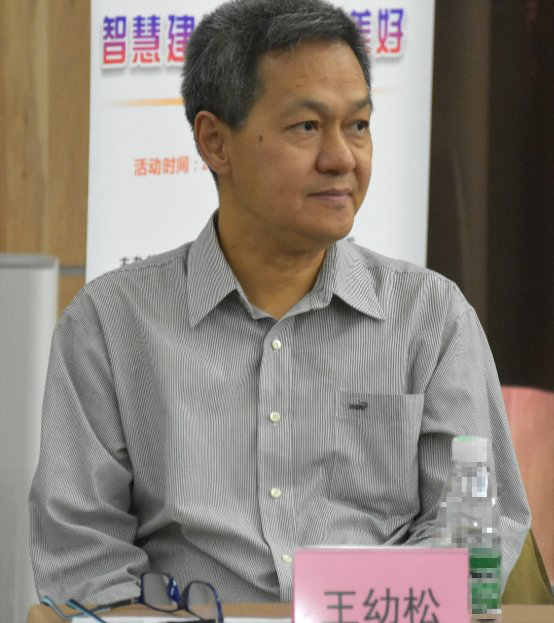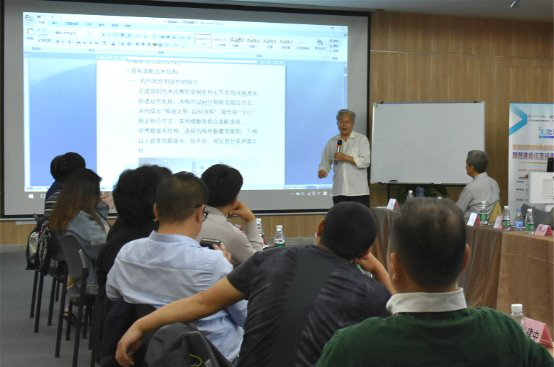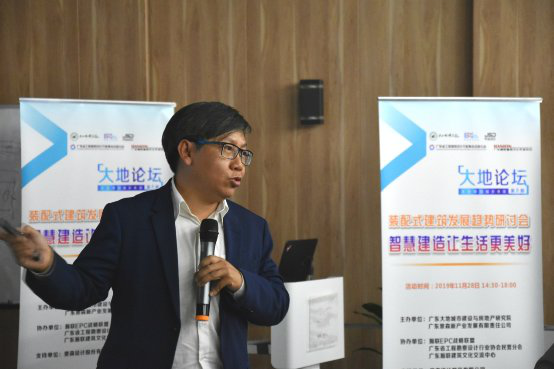As prefabricated construction technology research in recent years gradually improved, rising labor costs and the support of national policy level, our country is in prefabricated construction to a new stage of development, according to the ministry data, by the end of 2018 China's new prefabricated building area of 290 million square meters, accounted for 13.9% of the total area of the new houses. But what is the current situation and attitude of the market in the process of policy promotion? Under the trend of smart city construction, what role and content does prefab architecture play?
On the afternoon of November 28, 2019, the "Dadi Forum", a high-end activity brand of Guangdong Dadi Urban Construction and Real Estate Research Institute (hereinafter referred to as "Dadi Research Institute"), was held as scheduled in a brand new form. In this seminar co-sponsored by The Earth Research Institute and Guangdong Jingsen New Industry Development Co., LTD., there were four earth think tank experts sharing the theme of this activity for us.
The event theme "wisdom to build better life", to "prefabricated construction trends seminar" as the breakthrough point, invited a number of domestically fabricated building of celebrities, profound research and practical experience of prefabricated construction policy, industry development, market case, development in overseas markets, such as public entities discussion level, launched a keynote speech and communication are discussed.
Wang Yousong, vice President of Guangdong Dadi Urban Construction and Real Estate Research Institute and professor of Architecture of South China University of Technology, delivered a keynote speech entitled "Smart City and Prefabricated Building Performance". Professor Wang Yousong started from the analysis of the experimental data of various indicators such as resources and environment of prefabricated buildings, and believed that prefabricated buildings could effectively reduce the consumption of resources. If the prefabrication rate could be further improved and the standardized design of components could be strengthened, there would be great potential in the future. In the long run, smart architecture is the development trend of the future, but prefab architecture cannot be driven by policies alone. It also needs the recognition and cooperation of the market.

Wang Yousong's Speech "Smart City and Prefab Building Performance"
Huang Zhenliang, an expert consultant of Guangdong Gedi Urban Construction and Real Estate Research Institute, and a professor of Guangzhou University's School of Architectural Planning, published a theme sharing entitled "Three Types of Prefabricated Building Structural Systems and Two Production Methods" with the origin and development of prefabricated building as the core. Professor Huang Zhenliang believes that to discuss the development trend of a thing, we should first look at its origin, and the wooden building components with a history of thousands of years in China can be regarded as one of the origins of prefab architecture. With the continuous development of wooden components, even across the sea to the Japanese construction industry to a deep impact, and gradually formed one of the styles of contemporary Japanese architecture - prefabricated assembly structure.In North America, this style has even been applied to the design of RVS. Field assembly needs to solve the environmental flexibility, overall stability, the tightness between structural components, while the factory prefabricated assembly of light mobile housing performance is controllable, good cost performance, there is a market prospect.
Professor Huang Zhenliang puts forward a hypothesis: compared with smart cities, he thinks organic cities are more humanized, and prefabricated buildings are indeed more conducive to the construction and development of organic cities than traditional building methods. However, urban development cannot be achieved overnight. In the final analysis, it is the market that decides how to satisfy people's yearning for a better life.

Huang Zhenliang's speech on Three Types of Prefabricated Building Structural System and Two Production Methods
In the current situation of prefabricated buildings in China, Deng Jinghua, national first-class registered architect and vice President of Jingsen Design Co., LTD., proposed a new direction for us: to lead our new technology overseas, namely "The development of Prefabricated Buildings in Australia and New Zealand". With the help of local governments, Mr. Deng believes the prefab construction market, once a blue ocean, will turn into a competitive red sea as more and more companies flock to the market. The wait-and-see of the market and the run-in of new things indicate that the development of prefabricated buildings in the domestic market is not smooth sailing. Taking advantage of the national One Belt And One Road go out policy, the prefab construction industry can also turn to foreign markets. Australia and New Zealand in the southern hemisphere, however, present a lot of opportunities due to the surging population and insufficient housing supply. In this context, we have the opportunity and ability to fight in overseas markets and create a broader living space. In the sharing process, Mr. Deng Jinghua analyzed the current situation of the real estate market in Australia and New Zealand, the advantages and disadvantages of prefabricated buildings entering the market, and various matters that domestic enterprises should pay attention to when entering the market.

Deng Jinghua's Speech on the Development of Prefab Architecture in Australia and New Zealand
Chen Cheng, general manager of Guangdong Jingsen New Industry Development Co., Ltd. gave a speech entitled "Smart City -- Public Facility System Solution" from the perspective of practical application and combined with various new products under the company. According to Chen Cheng, prefabricated building, as a new thing in the field of architecture, has many advantages such as high efficiency, energy saving, creativity, technology and flexibility, although there are still some problems to be discussed in terms of cost, operation and landing. When the market is still looking and seeing, the government and enterprises should shoulder the heavy responsibility of promoting new things and improving people's living standards, and demonstrate the advantages and significance of prefabricated buildings in the field of public service facilities for the market.

Chen Cheng's speech "Smart City -- Solutions of Public Facility System"
Chen cheng said that in the process of building a smart city in the whole industry, there is a lack of systematic and overall planning capability of service providers everywhere. For owners, there is no centralized platform to connect and manage them, leading to inefficient and overlapping expenditure and service costs. For service providers, there is no resource integration, no combination of strong, unable to form a scale. JingSen new industry hopes to shoulder "to create the last kilometer" wisdom city service responsibilities, from the perspective of city planning, architectural design and overall layout, the wisdom of form a complete set "makes the city the last kilometer" is the core idea, in the field of urban renewal supporting services, relying on the advantage of prefabricated construction, provide the system solution. At present, The new jingsen industry has established creative prefabricated garbage stations and intelligent prefabricated public toilets, and is actively promoting mobile prefabricated fire stations.